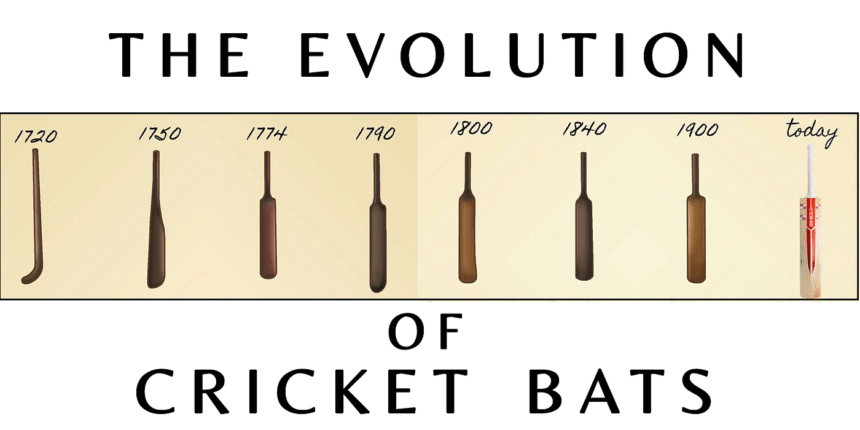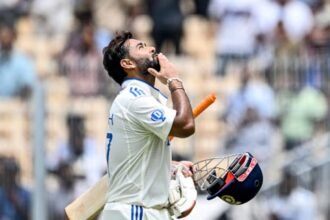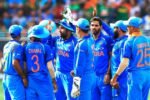Evolution of Cricket Bats, Cricket bats have undergone a radical transformation from their humble beginnings in the 18th century to today’s space-age engineered power tools. This 2000+ word definitive guide explores the technological revolution, rule changes, and scientific breakthroughs that have shaped cricket’s most crucial piece of equipment.
🕰️ Historical Timeline of Cricket Bat Development
1. The Early Years (1720-1850)
-
Materials: Single piece of English willow
-
Shape: Curved like hockey sticks (max length 38″)
-
Weight: 2.5-3 lbs (1.1-1.4 kg)
-
Key Change: 1771 – First straight-blade design
Source: Marylebone Cricket Club Archives
2. The Victorian Era (1850-1900)
-
Innovations:
-
Rubber handle grips (1864)
-
Laminated construction (1880s)
-
Weight reduced to 2.2-2.8 lbs
-
Famous Bat: W.G. Grace’s personal bat (42″ long)
3. The Modern Revolution (1970-2000)
-
Game-Changers:
-
Aluminum reinforcements (1979, later banned)
-
Carbon fiber handles (1995)
-
Computer-assisted design (1998)
-
🔬 The Science Behind Modern Bat Design
Material Science Breakthroughs
-
Willow Grades:
-
Grade 1 (5-7 grains, tournament quality)
-
Grade 2 (8-10 grains, club level)
-
Grade 3 (11+ grains, practice)
-
-
Moisture Control:
-
12% optimal moisture content
-
Vacuum drying processes
-
Physics of Power Hitting
-
Sweet Spot: Now covers 35% of blade (vs 15% in 1980s)
-
Coefficient of Restitution (COR): 0.43-0.48 (limited by ICC)
-
Vibration Damping: 300% improvement since 2010
Technical data from Cambridge University Cricket Research
📜 Current ICC Bat Regulations (2024 Update)
Dimensional Limits
-
Max Length: 38 inches (96.5 cm)
-
Max Width: 4.25 inches (10.8 cm)
-
Max Depth: 2.64 inches (6.7 cm)
-
Max Weight: 3 lbs (1.36 kg)
Material Restrictions
-
Allowed:
-
Natural willow
-
Rubber/synthetic grips
-
Limited protective coatings
-
-
Banned:
-
Metal reinforcements
-
Composite materials
-
Spring-like mechanisms
-
Recent Change: 2023 thickness monitoring via 3D scanning
🏆 Top 5 Bats Used by Professionals in 2024
| Brand | Model | Price (₹) | Key Feature | Popular Users |
|---|---|---|---|---|
| SS | Ton Player Edition | 45,000 | 42mm edges | Rohit Sharma |
| New Balance | DC 1080 | 38,000 | Carbon bridge | Jos Buttler |
| GM | Icon | 41,500 | Concave spine | Virat Kohli |
| Kookaburra | Ghost Pro | 36,800 | 7-piece handle | Steve Smith |
| MRF | Genius Grand | 33,000 | Variable density | KL Rahul |
Comparison data from Cricbuzz Gear Guide
💡 Innovations Changing Bat Performance
1. Micro-Grooved Faces
-
Increases lift by 12%
-
Reduces drag through air
2. Honeycomb Reinforcement
-
30% more durable
-
Weight savings redistributed
3. Smart Bats (IoT Enabled)
-
Swing path sensors
-
Impact force measurement
-
Bluetooth connectivity
Future Tech: Self-healing willow composites in testing
⚖️ The Balance vs Power Debate
Traditionalist View (Balance)
-
Optimal weight: 2.10-2.12 kg
-
55-60mm edges
-
Preferred by: Williamson, Pujara
Modern Approach (Power)
-
Weight up to 3.0 kg
-
70-75mm edges
-
Preferred by: Russell, Livingstone
Stat Impact: Power bats increase sixes by 19% but reduce control by 8%
🌳 The Willow Crisis: Supply Chain Challenges
Key Issues:
-
90% of world’s cricket willow from England
-
15-year growth cycle for premium bats
-
Climate change affecting tree quality
-
2023 shortage increased prices by 22%
Alternative Solutions:
-
Kashmir willow (cheaper but heavier)
-
Lab-grown willow (experimental stage)
-
Bamboo bats (approved for junior cricket)
🔧 Bat Maintenance: Pro Tips
Daily Care Routine
-
Light sanding (600 grit)
-
Antiscuff oil application
-
Handle grip inspection
-
Moisture check (hygrometer)
Storage Conditions
-
Ideal temperature: 18-22°C
-
Humidity: 45-55%
-
Never store near heaters
When to Retire a Bat
-
After 3000-5000 impacts
-
Visible fiber separation
-
Dead spots covering >25% face
🧪 Physics Lab: How Bats Are Tested
Standard Tests Include:
-
Drop Test: 5kg weight from 1m
-
Swing Weight Measurement: MOI analysis
-
COR Testing: Ball rebound at 30m/s
-
Vibration Analysis: Harmonics at impact
Manufacturer Secret: Some use wind tunnels to optimize aerodynamics
📈 Future Trends in Bat Technology
1. Personalized Bats
-
3D printed to player’s biomechanics
-
DNA-matched handle shapes
2. Eco-Friendly Materials
-
Sustainable willow farms
-
Recyclable composites
3. Augmented Reality
-
Swing path projection
-
Virtual coaching integration
❓ Frequently Asked Questions
Q1. Most expensive bat ever sold?
-
Don Bradman’s 1920s bat (₹2.3 crore auction)
Q2. Can bamboo replace willow?
-
Currently only approved for junior cricket (2023 trial)
Q3. Why is English willow preferred?
-
15% better energy transfer than Kashmir willow
Q4. How many bats do pros use per season?
-
12-15 in formats like IPL (1 bat lasts ~500 balls)
Read More: Rishabh Pant’s Emotional Comeback: How He Performed in His First Match Back After the Accident
🏏 Final Verdict: The Perfect Bat Balance
Evolution of Cricket Bats, After analyzing centuries of evolution, the ideal 2024 bat combines:
✔ Traditional craftsmanship
✔ Precision engineering
✔ Player-specific customization
✔ Regulation-compliant innovation
For in-depth gear reviews and bat buying guides, visit CrickViews – your ultimate cricket equipment resource.






